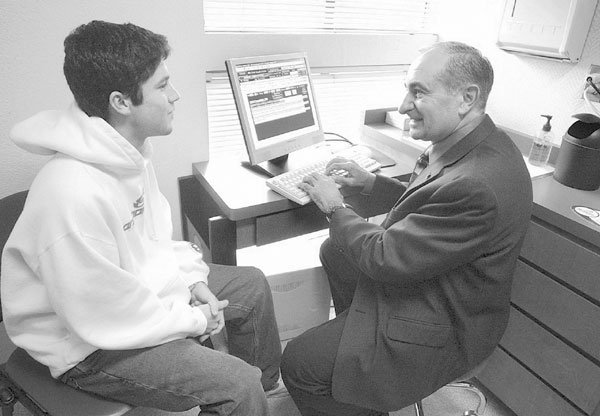It doesn’t matter whether a physician’s script is neat, crisp
and legible; to the public,
”
doctor’s handwriting
”
still implies the worst qualities of penmanship.
It doesn’t matter whether a physician’s script is neat, crisp and legible; to the public, “doctor’s handwriting” still implies the worst qualities of penmanship.
That reputation has been earned over many decades, but it’s gone beyond a running joke. It can also be deadly. If prescriptions or medical records are misread, serious errors can occur.
Gilroy family doctor Joseph Barbara doesn’t have that problem. Everything is computerized at his clinic, the We Care Health Center in the Gilroy Medical Park on Wren Avenue.
All prescriptions, X-ray requests, etc. are printed rather than handwritten. Patients’ files are stored in silicon chips rather than manila folders. Barbara even takes his notes on a computer while seeing patients.
The We Care clinic has been that way since 1998, a year before a study from the National Academy of Sciences’ Institute of Medicine shocked Congress and the public by revealing that medical errors kill an estimated 100,000 people a year. Some 7,000 of those die from improper medication, and doctors’ handwriting is often the culprit.
Five years after that report, the medical community is changing, albeit slowly. More and more doctors – especially young ones – are typing their notes and directives into computers rather than writing them on paper.
The Kaiser Gilroy Medical Center encourages – but doesn’t yet require – doctors to use its “e-prescription” and “e-chart” options, according to Dr. Timothy Tsang, a urologist at Kaiser Santa Teresa Hospital in San Jose.
Both Kaiser and Saint Louise Regional Hospital in Gilroy have databases on which doctors can check patients’ charts and what medications they’re taking. Both also plan to roll out more extensive electronic health record systems in the near future.
But Barbara, who has been practicing in Gilroy for 30 years, is still way ahead of the curve. No other family doctor – and perhaps any doctor – in the South Valley has yet caught up to the technological standard he set six years ago.
A South Valley Newspapers poll discovered that every single other licensed family doctor in Gilroy, Hollister and Morgan Hill uses paper records predominantly, with handwritten prescriptions being the norm.
Kaiser and Saint Louise, despite their technological advances, still use paper records extensively, and Hazel Hawkins Medical Center in Hollister also has a paper-based system.
“Surprisingly, probably 90 to 95 percent of all doctors still use the old handwritten notes,” said Barbara, 57. “My generation, most people are afraid of computers, and especially doctors.”
In 10 years, or maybe 20, all doctors’ offices could be paperless. The 1999 Institute of Medicine report made waves, and federal lawmakers are putting pressure on doctors to go digital as soon as possible. For doctors, more so than most professionals, the computer revolution is in the national eye.
“The policy makers in Washington are watching,” Rosemarie Sweeney, the American Academy of Family Physicians’ vice president for socioeconomic affairs and policy analysis, said at a Jan. 12 meeting with computer company representatives. “If what we’re trying to do here succeeds, we have a much better chance of seeing legislation passed that supports our vision of the future of (electronic health records). What we all want to avoid is a government mandate.”
The AAFP in November announced a deal with computer companies to secure discounts for its members on software and hardware. Whether a clinic is big or small, one big reason they don’t go digital is the overhead cost.
“Surveys and direct contact with AAFP members demonstrate their strong desire to adopt and utilize computerized systems,” the AAFP stated in an October Web posting. “However, the many challenges – including high initial capital costs; inability to exchange health data with other doctors, hospitals or patients; and concerns about privacy and security introduced by HIPAA (the Health Insurance Portability and Accountability Act of 1996, which protects patient privacy) – have made computerization of the modern family practice a daunting, almost overwhelming task for the average physician and his or her office staff.”
Daunting or not, the We Care clinic is a shining example that it can be done – in-house, no less.
The We Care clinic didn’t buy its software or borrow its data-sorting system. It developed its own. Barbara didn’t know how much that do-it-yourself mentality cost in staff hours, but it may soon pay off – and in more than just efficiency, safety and professional pride. Other clinics are now interested in buying the software We Care created.
“It’s worked out so well,” Barbara said. “We’re in the process of getting it ready for market right now.”
In addition to being safer, Barbara said computers are essential for efficiency.
“Considering that we are a pretty big office with a big patient clientele, it would be almost impossible to deal with these patients appropriately if you couldn’t pull up their information on a computer,” Barbara said.
“It’s making the practice a little easier,” he said.















